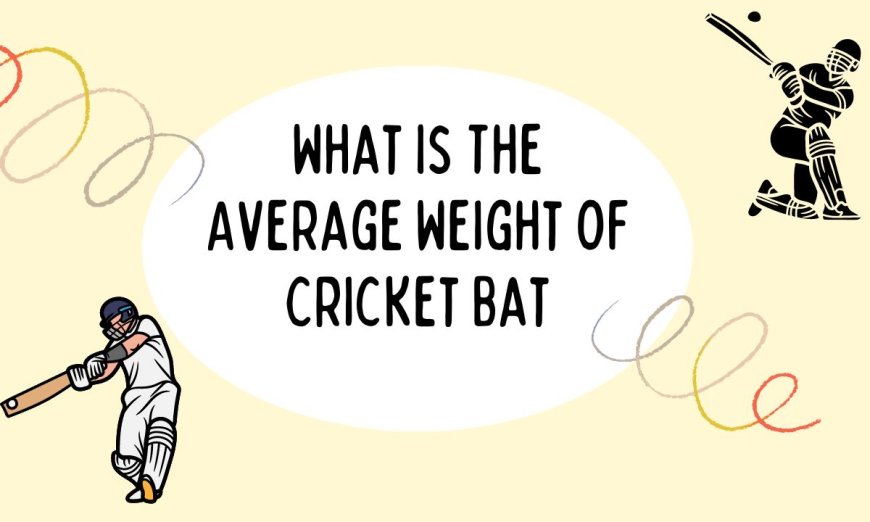What Is The Average Weight Of Cricket Bat
Cricket, a sport rich in tradition and strategy, is as much about skill and technique as it is about the equipment used by players. Among the various pieces of equipment, the cricket bat holds paramount importance. The choice of a cricket bat can significantly impact a player's performance. One of the crucial aspects of selecting a cricket bat is its weight. This comprehensive guide will delve into the intricacies of the average weight of a cricket bat, exploring various factors that influence it, the impact of weight on performance, and how players choose the right bat for their needs.
Historical Evolution of Cricket Bats
Before diving into the specifics of bat weight, it's essential to understand how cricket bats have evolved over time. The earliest cricket bats, dating back to the 16th century, were more akin to hockey sticks, with a curved design to hit rolling balls. As the game evolved, so did the bats. By the 18th century, bats began to resemble their modern counterparts, with a flatter surface and a more pronounced blade.
In the 19th century, cricket saw significant changes in bat design. The introduction of round-arm and then over-arm bowling meant that bats needed to be more robust and better suited to deal with bouncing balls. This led to the development of the modern straight bat with a well-defined spine and sweet spot.
Materials Used in Cricket Bats
The material of a cricket bat is a significant determinant of its weight. Traditionally, there are two types of cricket bats: English willow and Kashmir willow cricket bat.
English Willow
English willow is renowned for its superior quality and performance. It is a soft, fibrous wood that provides excellent resilience and a good balance between weight and power. English willow bats are preferred by professional and serious amateur players due to their performance characteristics. These bats typically weigh between 2.7 to 3 pounds (1.2 to 1.36 kg).
Kashmir Willow
Kashmir willow is more affordable and is generally used for lower-end bats. It is slightly harder and heavier than English willow, making these bats a bit more cumbersome. Kashmir willow bats usually weigh between 2.9 to 3.2 pounds (1.3 to 1.45 kg).
The Average Weight of Cricket Bats
The weight of a cricket bat can vary significantly based on several factors, including the type of willow, the player's preference, and the style of play. However, most cricket bats used by adult players fall within a specific weight range.
General Weight Range
-
Lightweight Bats: 2.6 to 2.9 pounds (1.17 to 1.31 kg)
-
Medium Weight Bats: 2.9 to 3.1 pounds (1.31 to 1.41 kg)
-
Heavyweight Bats: 3.1 pounds (1.41 kg) and above
Professional Players' Preferences
Professional cricketers often have their bats custom-made to suit their specific needs. The average weight of bats used by professional players typically falls between 2.8 to 2.9 pounds (1.27 to 1.31 kg). However, some players prefer heavier bats for the additional power they can generate, while others opt for lighter bats to ensure quicker bat speed and better maneuverability.
Factors Influencing Bat Weight Choice
-
Batting Style: Aggressive players who rely on powerful shots might prefer heavier bats, while players who rely on timing and placement often choose lighter bats.
-
Physical Strength: Stronger players can handle heavier bats without compromising their technique, whereas younger or less physically robust players might find lighter bats more manageable.
-
Playing Conditions: Heavier bats are often favored in conditions where the ball bounces less, allowing players to play more aggressively. Conversely, in bouncy conditions, lighter bats offer better control and maneuverability.
The Science Behind Bat Weight and Performance
The weight of a cricket bat directly influences various aspects of a player's performance. Understanding the science behind this can help players make more informed choices.
Bat Speed and Control
Lighter bats are easier to swing, allowing for faster bat speed. This can be crucial in executing quick shots, especially against fast bowlers. Higher bat speed also aids in playing delicate shots like cuts and glances, where precision and timing are vital.
Power and Impact
Heavier bats can generate more power, making it easier to hit boundaries. The additional mass of a heavier bat means that, when it strikes the ball, more force is imparted, resulting in longer shots. This is particularly beneficial for aggressive batsmen who play a lot of attacking shots.
Fatigue and Endurance
Over the course of a long innings, a lighter bat can help reduce fatigue. Players who prefer lighter bats often find that they can maintain their form and technique for extended periods without the bat feeling cumbersome. This is particularly important in longer formats of the game, such as Test cricket.
Balance and Pickup
The balance of a cricket bat, or how it feels in the hands, is just as important as its actual weight. A well-balanced bat with a good pickup can feel lighter than its actual weight, making it easier to control. Bat makers achieve this by distributing the weight along the bat's length, with particular attention to the placement of the sweet spot.
Customization and Personalization
Modern bat manufacturers offer extensive customization options to cater to individual preferences. This customization extends beyond just weight and includes factors such as:
-
Handle Type: The shape and thickness of the handle can affect how a bat feels. Oval handles offer a different grip compared to round handles, influencing how a player swings the bat.
-
Blade Profile: The distribution of wood along the bat's blade, including the spine and edges, can impact the bat's balance and performance. Thicker edges and a higher spine can enhance power without significantly increasing weight.
-
Sweet Spot Position: The location of the sweet spot can be tailored to match a player's typical shot-making style. Some players prefer a lower sweet spot for front-foot drives, while others might favor a mid or higher sweet spot for back-foot play.
Junior and Women's Bats
The average weight of cricket bats also varies significantly for junior and women's cricket. Junior bats are designed to be lighter to accommodate the strength and technique of younger players.
Junior Bats
-
Ages 5-7: 1.7 to 2.2 pounds (0.77 to 1.0 kg)
-
Ages 8-10: 2.2 to 2.6 pounds (1.0 to 1.17 kg)
-
Ages 11-13: 2.6 to 2.9 pounds (1.17 to 1.31 kg)
-
Ages 14-15: 2.9 to 3.1 pounds (1.31 to 1.41 kg)
Women's Bats
Women’s cricket bats are typically lighter than men’s bats, reflecting differences in average strength and technique. These bats generally weigh between 2.6 to 2.9 pounds (1.17 to 1.31 kg), similar to the lighter end of the scale for men’s bats.
Maintenance and Its Impact on Weight
The maintenance of a cricket bat can also influence its weight over time. Proper care can ensure that a bat retains its performance characteristics, while neglect can lead to changes in weight and balance.
Knocking-In
New cricket bats, especially those made of English willow, require a process known as knocking-in. This involves striking the bat’s surface with a mallet to compress the fibers and create a hardened layer. Proper knocking-in ensures the bat performs well and lasts longer. While this process does not significantly change the bat’s weight, it affects its durability and performance.
Oiling
Applying linseed oil to a cricket bat helps to maintain its moisture content and prevent the wood from drying out and cracking. Over-oiling, however, can add unnecessary weight to the bat. It is crucial to apply oil sparingly and allow it to soak in properly.
Repairs
Over time, cricket bats can develop cracks and other damage, especially on the edges and toe. Repairing these damages, such as by adding protective facing or fibreglass tape, can slightly increase the bat’s weight. Regular maintenance, including addressing minor damages promptly, can help prevent significant weight changes.
Technological Advances and Modern Bat Design
Recent advancements in technology have led to innovative designs in cricket bats, aiming to optimize performance while managing weight. These innovations include:
Lightweight Materials
While traditional bats are made entirely of willow, some modern designs incorporate lightweight materials such as carbon fiber in the handle or spine. These materials can reduce the overall weight of the bat while maintaining or even enhancing its strength and performance.
Precision Engineering
Computer-aided design (CAD) and other precision engineering techniques allow manufacturers to create bats with highly optimized profiles. This ensures that the weight is distributed more effectively, providing a better balance and feel without sacrificing performance.
Enhanced Sweet Spot
Advancements in manufacturing techniques have enabled the creation of bats with enlarged sweet spots. This means that even mis-hit shots can travel farther, providing a significant advantage to players. Achieving this without increasing the weight of the bat is a testament to the precision and innovation in modern bat design.
The Psychological Aspect of Bat Weight
The psychological comfort a player derives from their bat can be as important as its physical characteristics. Confidence in one’s equipment can significantly influence performance. A bat that feels right in the hands, balanced and of the appropriate weight, can boost a player’s confidence, allowing them to focus more on their game rather than worrying about their equipment.
Pre-Game Rituals
Many players have specific pre-game rituals involving their bats, such as knocking-in, oiling, and applying protective tape. These rituals are not just about maintenance but also serve to establish a bond between the player and their bat, enhancing confidence and mental preparedness.
Conclusion
In conclusion, the average weight of a cricket bat is a crucial consideration for players of all levels. It affects performance in terms of bat speed, power, and endurance, making it essential for players to choose a bat that suits their playing style and physical attributes. From the historical evolution of cricket bats to modern innovations in design and materials, the quest for the ideal bat continues to evolve. Whether you are a professional cricketer or an amateur enthusiast, understanding the nuances of bat weight can help elevate your game and appreciation of this beloved sport.
What's Your Reaction?


























